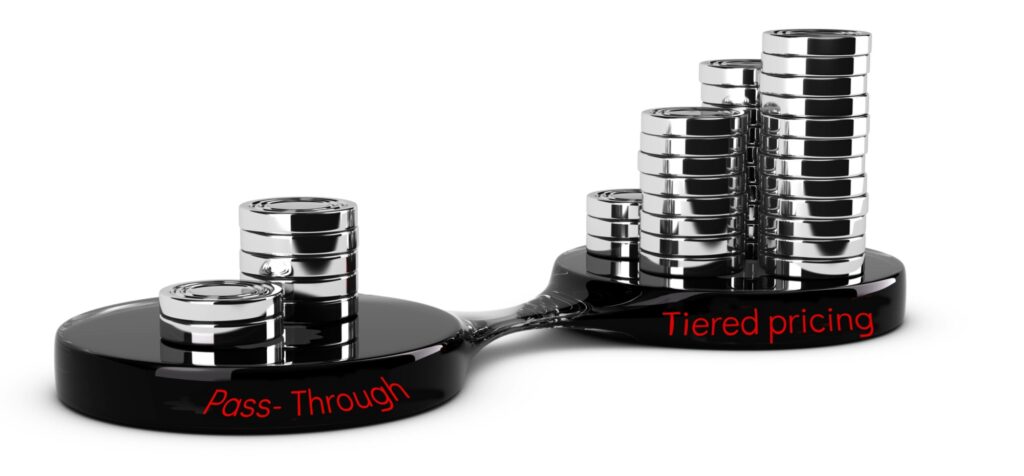
A pervasive question among merchants is which is better, Interchange pass-through pricing or tiered pricing. In an industry constantly marred by ethical complaints along with strict prudential regulation, it would help to understand the difference between the two. Understanding the nuances of both options can help merchants make an informed decision of which pricing structure is right for them.
How do interchange fees work
Let’s start with how interchange fees work. Interchange fees are the charges paid to the bank that issued the card. Suppose a customer purchases with a Visa debit card issued by Citibank. In that case, Starbucks will have to pay Citibank and the payment processor an interchange fee at whatever the general agreed-upon rate is for that transaction. Most major payment networks, such as Visa, Mastercard, Discover, etc., publish their rates online. Although the rates are already agreed upon, the actual rate which is applicable is unknown until the customer uses the card as multiple variables determine the final rate all the way up to the transaction taking place.
These variables can include the type of card being used (credit card or debit), the category of the card (corporate, fleet, standard, rewards, etc.) and the transaction type (was the card swiped or did a teller have to key it in), nature of services purchases (is the customer buying coffee or guns), among many others.
Consider all the varieties of a transaction and multiply that by the different rates charged for them by the many payment processing networks, American Express, Diner’s Club, Discover, JCB, Mastercard, Visa, and many more.
What is Interchange pass-through pricing?
Interchange pass through, or interchange-plus pricing, passes through the payment network’s published cost plus a nominal markup as the name suggests. That markup being charged is the fee the payment processor earns for facilitating the transaction. These markups can change based on the risk profiles of the merchant industries served.
This pricing option is much more transparent and, often, is the cheaper alternative to tiered pricing. The only drawback to this pricing option is that the merchant account billing statement can include a detailed line-item breakdown of all the different interchange rates applicable by all payment networks accepted by the merchant. Call it too much transparency!
What is Tiered Pricing?
Tiered pricing was introduced to simplify the numerous different interchange rates that are applicable for a merchant. The payment processor would present only a few rate categories relevant that would show up a merchant’s billing statement.
Tiered pricing bundles interchange fees into three categories or tiers (or more based on the processors’ choosing). Tiered pricing is shown on a merchant statement as broken down into the qualified, the mid-qualified, and the non-qualified tiers. Each of these tiers has a specific rate that becomes the merchants’ interchange fee rate for all cards that fall into the respective tiers.
For example, let’s say that the qualified tier’s interchange fee rate is 2%. Suppose the processor classifies a Mastercard debit card and a Visa debit card into a qualified tier, the Interchange, the merchant processor. In that case, would charge the vendor for accepting Visa or Mastercard debit cards is 2%.
Similarly, other card types (corporate cards or rewards cards) fall into different tiers charged a higher rate. Effectively, the card processors offering tiered plans group or bundle numerous card types into specific interchange fees.
This becomes even more pronounced as payment networks that set lower rates for sellers of small ticket items, such a coffee shop or a convenience store. The logic is that the merchant can save money with a lower interchange rate with every transaction but the payment networks can still make money based on the volume of transactions. However, none of these savings are available for Merchants which opt for the tiered pricing plan.
Finally, unlike interchange pass-through rates, it’s impossible to compare pricing plans among payment processors offering tiered pricing. That is because the processors decide the tiers they will set and what the criteria will be for them.
How is Tiered pricing bad?
The problem with tiered pricing is that it can cost merchants a lot more in interchange fees. The interchange fee rates charged by the payment networks can be markedly lower than the tiered rates charged by the processor, depending on how the payment processor groups card types.
A Visa Debit card may only carry an interchange rate of just 0.25%. However, at the lowest qualified tier rate of a processor, maybe 2%, and that is what the merchant will pay. The difference between what the merchant was charged and what Visa charges will be pocketed by the payment processor.
There is no transparency for these rate differentials for merchants offered tiered pricing structure. Merchants may not even be aware that such differences exist. Given the complexity of all the moving parts of interchange fees, payment processors don’t need to do much with the opaque tiered pricing system to increase merchants’ operating costs. They can simply bundle more of the lower interchange fee transactions into the mid-qualified and non-qualified tiers, and merchants would be none the wiser.
Finally, with tiered pricing, processors keep the credits for refunds. When merchants issue refunds for card transactions, they should be given a credit for the interchange fees charged on those transactions. As interchange categories are bundled in tiered pricing, those interchange credits are not refunded back to the merchant. That is just added to the payment processor’s bottom line.
For example, if a retailer issued a refund to a card-paying customer, the retailer’s interchange fee was charged by the payment processors on the voided transaction is not refunded.
There are some very considerable drawbacks to a tiered pricing structure. In the guise of simplicity is a product that is not a transparent, fair, nor cost-effective option for merchants. Alternatively, interchange pass through offers rates that are much more consistent with what payment networks charge. All transactions are broken down by cost, and merchants get refunds when due.
